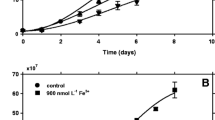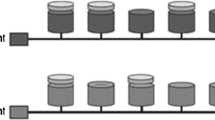Abstract
Plant phenols tend to accumulate under conditions where plants have excess carbon above the level which can be used for growth, and where phenylalanine, the substrate of phenylpropanoid synthesis, accumulates due to suppressed protein synthesis. These internal balances imply an accumulation of phenols as a consequence of nitrogen deficiency suppressing plant primary metabolism. In three sublittoral populations of the brown alga Fucus vesiculosus (L.) collected from the northern Baltic Sea between May and September 1982, the accumulation of phenolic compounds correlated inversely with nitrogen content of thallus; higher phenolic contents were on average found under nitrogen deficiency. Phenolic content did not correlate with carbon content of thallus as such, while a significant negative correlation was found with the nitrogen: carbon ratio. Phenolic compounds, although having possibly defensive functions in plants, may thus partially vary as a function of resource availability rather than as a result of an active allocation into plant defences.
Similar content being viewed by others
Literature cited
Bernays, E. A., Woodhead, E. (1982). Incorporation of dietary phenols into the cuticle in the tree locust Anacridium melanorhodon. J. Insect Physiol. 28: 601–606
Bryant, J. P., Chapin III, F. S., Klein, D. R. (1983). Carbon/nutrient balance of boreal plants in relation to vertebrate herbivory. Oikos 40: 357–368
Bryant, J. P., Chapin III, F. S., Reichhardt, P. B., Clausen, T. P. (1987). Response of winter chemical defense in Alaska paper birch and green alder to manipulation of plant carbon:nutrient balance. Oecologia (Berl.) 72: 510–514
Burns, R. E. (1963). Methods of tannin analysis for forage crop evaluation. Georgia, Agric. Exp. Stn. Tech. Bull. 32: 4–14
Chapman, A. R. O., Craigie, J. S. (1977). Seasonal growth in Laminaria longicurris: relations with dissolved inorganic nutrients and internal reserves of nitrogen Mar. Biol. 40: 197–205
Coley, P. D., Bryant, J. P., Chapin III, F. S. (1985). Resource availability and plant anti-herbivore defense. Science, N.Y. 230: 895–899
Del Moral, R. (1972). On the variability of chlorogenic acid concentration. Oecologia (Berl.) 9: 289–300
Feeny, P. P. (1968). Effects of oak leaf tannins on larval growth of the winter moth Opheroptera brumata. J. Insect Physiol. 14: 805–817
Feeny, P. P. (1970). Seasonal changes in oak leaf tannins and nutrients as a cause of spring feeding by winter moth caterpillars. Ecology 51: 565–581
Feeny, P. P. (1975). Plant apparency and chemical defense. In: Wallace, J. W., Mansell, R. L. (eds.) Biochemical Interactions between Plants and Insects. Plenum Press, New York, p. 1–40
Geiselman, J. A., McConnell, O. J. (1981). Polyphenols in brown algae Fucus vesiculosus and Ascophyllum nodosum: chemical defences against the marine herbivorous snail, Littorina littorea. J. chem. Ecol. 7: 1115–1133
Gershenzon, J. (1984). Changes in the levels of plant secondary metabolites under water and nutrient stress. In: Timmermann, B. N., Steelink C., Loewus, F. A. (eds.) Phytochemical adaptation to stress. Plenum Press, New York, p. 273–320
Janzen, D. H. (1974). Tropical black water rivers, animals and mast fruiting by the Dipterocarpaceae. Biotropica 6: 69–103
Johnson, C. R., Mann, K. H. (1986). The importance of plant defence abilities to the structure of subtidal seaweed communities: the kelp Laminaria longicruris de la Pylaie survives grazing by the snail Lacuna vincta (Montagu) at high population densities. J. exp. mar. Biol. Ecol. 97: 231–267
Khailov, K. M., Kholodov, V. J., Firsov, Y. K., Prazukin, A. V. (1978). Thalli of Fucus vesiculosus in ontogenesis: changes in the morpho-physiological parameters. Botanica mar. 21: 289–311
King, R. J., Schramm, W. (1976). Photosynthetic rates of benthic marine algae in relation to light intensity and seasonal variations. Mar. Biol. 37: 215–222
Kleiner, J. S., Orten, J. M. (1966). Biochemistry, 7th edn. The C.V. Masby Co., Saint Louis
Kornfeldt, R. A. (1982). Relation between nitrogen and phosprorus content of macroalgae and the waters of Northern öresund. Botanica mar. 25: 197–201
Levin, D. A. (1971). Plant phenolics: an ecological perspective. Am. Nat. 105: 157–181
Lincoln, D. E., Newton, T. S., Ehrlich, P. R., Williams, K. S. (1982). Coevolution of the checkerspot butterfly Euphydryas chalcedona and its larval food plant Diplacus aurantiacus: larval response to protein and leaf resin. Oecologia (Berl.) 52: 216–223
Margna, U. (1977). Control at the level of substrate supply — an alternative in the regulation of phenylpropanoid accumulation in plant cells. Phytochemistry 16: 419–426
Margna, U., Vainjärv, T. (1983). Kinetin-mediated stimulation of accumulation of buckwheat flavonoids in the dark. Z. Naturf. 38c: 711–718
Margna, U., Vainjärv, T., Margna, E. (1972). The influence of exogenous sugar feeding on the accumulation of anthocyanins and rutin in buckwheat seedling hypocotyls. Eesti NSV Tead. Akad. Toim., Biol. 21: 141–150
McKey, D., Waterman, P. G., Mbi, C. N., Gartlan, J. S., Struhsaker, T. T. (1978). Phenolic content of vegetation in two African rain forests: ecological implications. Science, N.Y. 202: 61–63
Mooney, H. A., Gulmon, S. L., Johnson, N. D. (1983). Physiological constraints on plant chemical defenses. In: Hedin, P. A. (ed.) Plant Resistance to Insects. Amer. Chem. Soc. Symp. Series 208: 21–36
Pedersen, A. (1984). Studies on phenol content and heavy metal uptake in fucoids. Hydrobiologia 116/117: 498–504
Phillips, R., Henshaw, G. G. (1977). The regulation of synthesis of phenolics in stationary phase cell culture of Acer pseudoplatanus L. J. exp. Bot. 28: 785–794
Ragan, M. A., Glombitza, K.-W. (1986). Phlorotannins, brown algal polyphenols. Prog. Phycol. Res. 4: 129–241
Ragan, M. A., Jensen, A. (1978). Quantitative studies on brown algal phenols II: Seasonal variation in polyphenol content of Ascophyllum nodosum (L.) Le Jol. and Fucus vesiculosus L. J. exp. mar. Biol., Ecol. 34: 245–258
Rhoades, D. F. (1979). Evolution of plant chemical defence against herbivores. In: Rosenthal, G. A., Janzen, D. H. (eds.) Herbivores: their Interactions with Secondary Plant Metabolites. Academic Press, New York, p. 3–54
Rönnberg, O. (1981). Traffic effect of rocky-shore algae in the Archipelago Sea, SW Finland. Acta Acad. Abo. Ser. B. 41: 1–86
Rönnberg, O., Ruokolahti, C. (1986). Seasonal variation of algal epiphytes and phenolic content of Fucus vesiculosus in a northern Baltic archipelago. Ann. Bot. Fenn. 23: 317–323
Salonen, K. (1979). A versatile method for the rapid and accurate determination of carbon by high temperature combustion. Limnol. Oceanogr. 24: 177–183
Steinberg, P. D. (1980). The potential role of phenolic compounds as herbivore defenses in brown algae. Amer. Zool. 20: 885
Steinberg, P. D. (1984). Algal chemical defenses against herbivores: allocation of phenolic compounds in the kelp Alaria marginata. Science, N.Y. 223: 405–406
Topinka, J. A. (1978). Nitrogen uptake by Fucus spiralis (Phaeophyceae). J. Phycol. 14: 241–247
Tuomi, J., Niemelä, P., Chapin III, F. S., Bryant, J. P., Siren, S. (1987). Defensive responses of trees in relation to their carbon/nutrient balance. In: Mattson, W. J., Levieux, J., Bernard-Dagan, C. (eds.) Mechanisms of woody plant defenses against insects: search for patterns. Springer-Verlag, New York, p. 57–72
Tuomi, J., Niemelä, P., Haukioja, E., Siren, S., Neuvonen, S. (1984). Nutrient stress: an explanation for anti-herbivore responses to defoliation. Oecologia (Berl.) 61: 208–210
Wallentinus, J. (1984). Partitioning of nutrient uptake between annual and perennial seaweeds in a Baltic archipelago area. Hydrobiologia 116/117: 363–370
Whitford, L. A., Schumacher, G. J. (1963). Communities of algae in North Carolina streams and their seasonal relations. Hydrobiologia 22: 133–196
Author information
Authors and Affiliations
Additional information
Communicated by T. Fenchel, Helsingør
Rights and permissions
About this article
Cite this article
Ilvessalo, H., Tuomi, J. Nutrient availability and accumulation of phenolic compounds in the brown alga Fucus vesiculosus . Mar. Biol. 101, 115–119 (1989). https://doi.org/10.1007/BF00393484
Accepted:
Issue Date:
DOI: https://doi.org/10.1007/BF00393484




